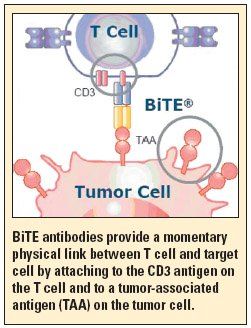Novel BiTE antibody mediates contact between T cells and cancer cells
SAN DIEGO-A new way of harnessing the body’s immune system to attack cancer cells has produced impressive preclinical and early clinical results, according to investigators interviewed at the 2008 American Association of Cancer Research annual meeting.
ABSTRACT: BiTE antibodies bind to both T cells and tumor cells to form a momentary link between them that sets off the deadly T-cell machinery.
SAN DIEGO-A new way of harnessing the body’s immune system to attack cancer cells has produced impressive preclinical and early clinical results, according to investigators interviewed at the 2008 American Association of Cancer Research annual meeting.
The novel compounds are antibodies called bi-specific T-cell engagers (BiTE). BiTE antibodies leverage the cytotoxicity of T cells by mediating contact between T cells and cancer cells, thereby inducing an immunological synapse between the two (see Figure). As a result, the T cells are able to deliver cytotoxic proteins into tumor cells, thereby eradicating not only the primary tumor but also micrometatases, said Christian Itin, PhD, who is CEO of Micromet, Inc, Baltimore.
The company name, in fact, derives from the company’s research philosophy that micrometastases are the fundamental challenge in eradicating cancer.
“With conventional antibodies, we fail to enlist the most potent part of the immune system, the T cells. The idea behind BiTE antibodies is to make a patient’s T cells capable of seeing the cancer,” Dr. Itin told ONI. With this in mind, researchers developed an “adaptor” that links T cells to tumor cells and activates the T cells.

“This technology is selective for the tumor, and it goes after rapidly growing as well as disseminating tumors,” he said. Moreover, when T cells encounter large numbers of tumor cells, they multiply and become formidable enough to take on even large tumor masses, he added.
According to Dr. Itin, these compounds are remarkably robust. “There are no other cytotoxic or biologic agents that come close to this level of potency, and in contrast to chemotherapy, there are no damaging bystander effects,” he said.
Several products under investigation
The most advanced product utilizing the BiTE technology is MT103, whose target antigen is CD19, which is present on most leukemia and non-Hodgkin’s lymphoma cells. MT103 is in phase II trials in acute lymphoblastic leukemia and NHL. Also in development is MT110, which targets the EpCAM antigen, expressed in 85% of all solid tumors. MT110 is now in phase I trials in gastrointestinal and lung cancer.
Two additional BiTE antibodies are in preclinical development for melanoma (MCSP specific) and acute myeloid leukemia (CD33 specific) (abstract 2404).
Dr. Itin also pointed to abstract 2402, which described the re-engineering of conventional antibodies-trastuzumab [Herceptin], cetuximab [Erbitux], and panitumumab [Vectibix]-into highly active BiTE antibodies. “We can essentially teach commercial antibodies new tricks-how to recruit T cells for a very selective and effective lysis of target cells,” he said.
Delivering the antibody
Allowing for the time it takes T cells to “scan” the entire body, the drug needs to be given over 4 to 8 weeks. “We have observed responses in 4 weeks, and with an additional 4 weeks managed to convert some partial responders to complete responders. Complete responders are offered another 4 weeks of consolidation therapy to give the T cells more time to find the last tumor cell. When the patient progresses, we think we can re-treat with this drug,” Dr. Itin said.
Currently, the drug is administered with a small pump for continuous delivery into the bloodstream. In the future, investigators expect to use subcutaneous delivery, possibly by means of a mini-pump like that used to deliver insulin to diabetics, said Peter Kufer, MD, PhD, vice president of immunotherapy at Micromet, who reported the feasibility of this approach (abstracts 2131 and 2403).
How Supportive Care Methods Can Improve Oncology Outcomes
Experts discussed supportive care and why it should be integrated into standard oncology care.